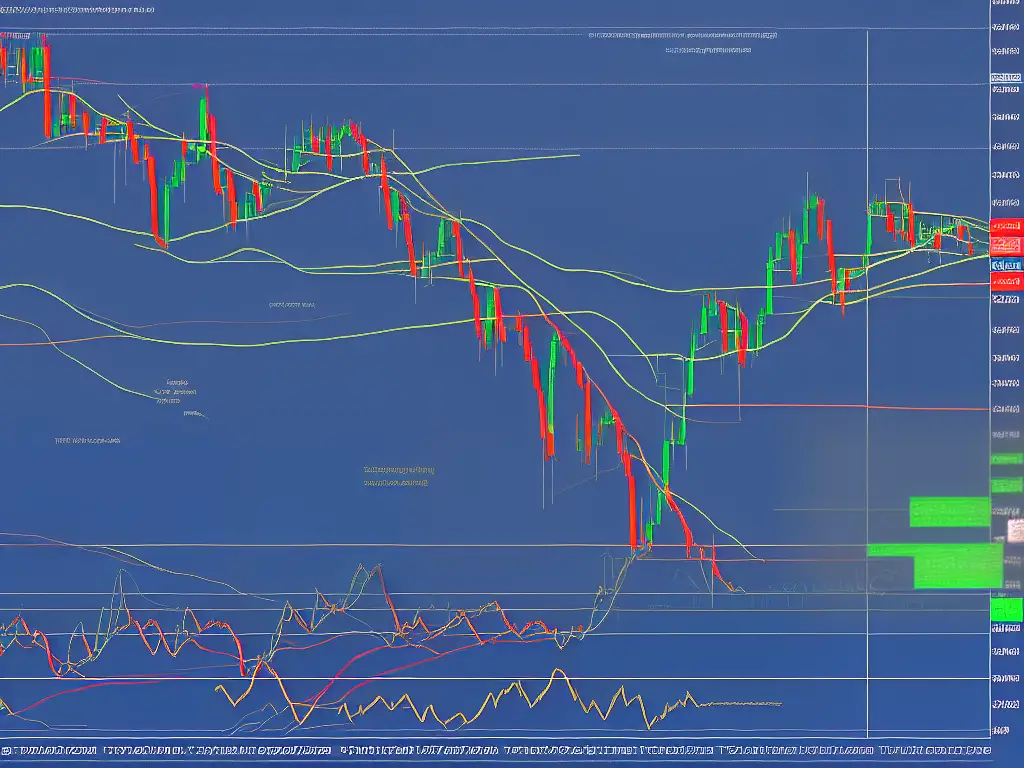The stock market can be an intimidating place, particularly for those who are just beginning to navigate its complexities. However, with the proper guidance and a comprehensive understanding of various concepts and strategies, it can become an accessible and valuable way to grow one’s wealth. In this essay, we will explore the fundamental principles of stock market investing, from understanding basic financial instruments to mastering intricate market strategies, in order to equip you with the knowledge necessary to confidently make informed financial decisions.
Basic Stock Market Concepts
Market indices and stock exchanges are fundamental concepts when it comes to understanding the stock market. A market index represents a specific market or market sector and can act as a benchmark to measure market performance or portfolio performance. The most commonly known market indices are the S&P 500 and the Dow Jones Industrial Average (DJIA).
Stock exchanges are organized marketplaces where buyers and sellers of stocks come together to trade. Some of the well-known stock exchanges are NYSE, NASDAQ, LSE, and TSE.
The stock market has two main types of investment instruments: stocks and bonds. Stocks represent a share of ownership in a company. Buying stocks means becoming a shareholder and potentially benefiting from a company’s growth through the appreciation of the stock price and potential dividend payments. Bonds are fixed-income securities that represent loans made by investors to corporations or governments. Payments to bondholders are predetermined interests and a return of the principal when the bond matures. While bonds are less risky, their potential returns are also lower than stocks.
Market capitalization is a crucial metric for understanding a company’s valuation. A company’s total number of outstanding shares and the market price per share determines market capitalization. This metric helps investors compare the sizes and valuations of different companies. Large-cap companies have a market cap of $10 billion or more, mid-cap companies range from $2 billion to $10 billion, and small-cap companies have less than $2 billion in market cap.
Understanding diversification is crucial in obtaining diverse knowledge about the stock market. Diversification, an essential concept to mitigate risk, involves investing across multiple instruments or sectors such as stocks, bonds, mutual funds, ETFs, and REITs. This approach helps spread investments and prevents putting all your eggs in one basket. Investors can diversify further by investing in different countries, sectors, industries, and varying the maturity dates of their bond investments.

Financial Statements
Moving on to another important aspect of the stock market is the analysis of financial statements, such as the balance sheet. The balance sheet provides a snapshot of a company’s financial position at a specific point in time and is divided into three main components: assets, liabilities, and shareholders’ equity. Assets include everything a company owns or has a right to, such as cash, inventory, and property. Liabilities represent the obligations a company has to other parties, like loans and accounts payable. Shareholders’ equity represents the residual interest in the company, which is the difference between assets and liabilities. In the stock market, investors often analyze a company’s balance sheet to evaluate its financial strength and overall stability, further supplementing their diversified investment approach.
Another crucial financial statement in the context of the stock market is the income statement. The income statement provides an overview of a company’s profitability over a specific period, typically a quarter or a year. This statement is divided into three parts: revenues, costs of goods sold (COGS), and operating expenses. Revenues are the total sales generated by a company during the reporting period, while COGS represents the direct costs associated with producing these goods or services. Operating expenses are all other costs incurred by a company in running its operations, such as overhead, taxes, and interest payments. Investors in the stock market use the income statement to assess a company’s profitability, its ability to increase revenues, and the effectiveness of cost management strategies.
The cash flow statement is another vital financial statement for stock market investors. This statement provides insights into how a company generates and uses cash over a specific period. The cash flow statement is divided into three sections: operations, investing, and financing. Cash from operations represents the inflows and outflows of cash relating to a company’s core business activities. Investing activities include inflows and outflows of cash from purchasing and selling assets, such as property, plant, and equipment, and making investments in other companies. Financing activities represent the borrowing and repayment of loans, issuing and repurchasing stock, and the payment of dividends. By analyzing a company’s cash flow, investors can determine its ability to generate cash, meet its obligations, and invest in its future growth.
Ratio analysis is another critical aspect of understanding and evaluating financial statements in the stock market. Ratio analysis involves using various financial ratios derived from a company’s financial statements to assess its financial health and performance. Some common financial ratios include liquidity ratios, such as the current ratio (current assets divided by current liabilities), which measures a company’s ability to pay its short-term obligations; profitability ratios, such as the net profit margin (net income divided by total revenues), to evaluate a company’s ability to generate profits from its revenues; and valuation ratios, such as the price-to-earnings ratio (stock price divided by earnings per share), to determine if a company’s stock is overvalued or undervalued.
Earnings per share (EPS) is another important stock market term associated with financial statements. EPS is calculated by dividing a company’s net income by the number of outstanding shares of its common stock. It serves as an indicator of a company’s profitability and is often used by investors to compare the earnings performance of different companies within the same industry. A higher EPS indicates a company’s better ability to generate profits for its shareholders. However, it is essential to consider other financial metrics and ratios alongside EPS to get a comprehensive understanding of a company’s financial health and potential for growth.
One critical aspect of stock market investing is understanding the balance sheet, income statement, and cash flow statement. These financial statements provide crucial insights into a company’s financial health, profitability, and growth potential. By analyzing these statements and their derived financial ratios, investors can make informed decisions regarding buying or selling a company’s stock or evaluating the overall performance of a particular industry.

Valuation Techniques
Furthermore, being familiar with various valuation techniques is vital for informed decision-making in stock market investments. Such methods help investors determine whether a stock is overvalued or undervalued. For instance, the discounted cash flow (DCF) analysis involves estimating a company’s future cash flows and discounting them back to their present value. By comparing this present value to the current stock price, investors gain a better understanding of whether a particular stock is worth purchasing, further highlighting the importance of diverse knowledge in stock market terminology.
Another popular valuation technique is the price-to-earnings (P/E) ratio analysis, which examines the relationship between a company’s stock price and its earnings per share. A high P/E ratio often indicates that a stock is overvalued, while a low P/E ratio may suggest that the stock is undervalued. This method helps investors compare the relative valuations of different companies, thereby identifying potentially lucrative investment opportunities. It’s important to note, however, that P/E ratios should generally be compared within the same industry, as different industries may have different average P/E ratios.
In addition to the aforementioned methods, dividend discount models (DDM) are frequently used as a stock valuation technique. DDM is particularly useful for valuing stocks that pay regular dividends, such as those found in the utility or consumer staples sectors. The basic premise of DDM is to calculate the present value of all future dividend payments that a company is expected to make, then compare it to the stock’s current price. If the present value of dividend payments is higher than the stock price, the stock may be undervalued, presenting a potential investment opportunity.
Investors can also employ the use of relative valuation techniques, such as the price-to-sales (P/S) ratio or the price-to-book (P/B) ratio, in their decision-making process. The P/S ratio compares a company’s stock price to its revenues and can be especially useful when valuing companies with little or no earnings, such as start-ups or those in highly competitive industries. The P/B ratio, on the other hand, evaluates a company’s stock price in relation to its book value, which represents the total value of a company’s assets, minus its liabilities. A low P/B ratio may suggest that a company’s stock is undervalued in relation to its net assets.
Understanding and applying various stock valuation techniques can be immensely helpful when navigating the complex world of stock market investing. By using methods such as discounted cash flow, price-to-earnings ratio, and dividend discount models, investors can gain valuable insights into the true value of a stock, helping them make well-informed investment decisions. As with any investment strategy, it’s essential to thoroughly research the company and the market before making any decisions, and to consult with a financial advisor if needed.

Portfolio Management
Moving beyond individual stocks, portfolio management is a critical aspect of investing in the stock market, as it involves the process of selecting and managing a collection of investments to achieve financial goals while managing risks. One of the key principles of portfolio management is diversification, which is the practice of spreading investments across various assets to minimize the overall risk. This is based on the premise that different asset classes will perform differently under varying market conditions, and by diversifying investments, one can potentially minimize losses in any one sector. As investors grow their understanding of stock valuation techniques, they can further refine their approach to creating a diversified portfolio that aligns with their individual risk tolerance and financial objectives.
Asset allocation is another crucial component of portfolio management. This refers to the process of distributing investments among various asset classes, such as stocks, bonds, and cash, in order to balance risk and reward. Determining the ideal asset allocation for an individual investor depends on various factors, including risk tolerance, investment horizon, and financial goals. By understanding these factors, investors can create a well-balanced portfolio that aligns with their investment strategy and risk profile.
Risk management is an integral element of managing a stock market portfolio. Investing always involves some level of risk, as the future performance of assets is uncertain. While it is impossible to eliminate risk entirely, investors can implement various strategies to minimize it. Aside from diversification and asset allocation, risk management may involve periodically reviewing and rebalancing the portfolio to ensure that it remains aligned with the investor’s goals and risk tolerance. Additionally, investors should consider factors such as their liquidity needs, tax considerations, and the potential impact of inflation on the value of their investments.
Having a well-balanced and diversified portfolio can offer several benefits for investors. Firstly, it can help to minimize the impact of declines in any one sector of the market, as losses in one area may be offset by gains in another. This can help to maintain more stable returns and reduce the overall volatility of the portfolio. Furthermore, diversification can also provide investors with exposure to various opportunities for potential growth, as no single asset class or sector is likely to consistently outperform others over the long term. This means that maintaining a diverse portfolio can improve the chances of achieving satisfactory returns over time.
Understanding correlations between different asset classes is an essential aspect of developing a well-balanced portfolio. This refers to the degree to which the performance of one asset is linked to the performance of another. Assets with high positive correlations tend to move in the same direction, while those with negative correlations often move in opposite directions. Investing in assets with varying correlations can further help to hedge against risk and minimize portfolio volatility. This highlights the importance of continually reviewing asset allocations and staying informed about market trends, allowing investors to make informed decisions that enhance their likelihood of success in the stock market.

Technical Analysis
One way to stay informed and make informed decisions is through the use of technical analysis, a popular methodology employed by stock market traders and investors to predict future price movements of stocks, forex, commodities, or any other traded financial instrument. This method primarily relies on the study of historical price data and patterns to forecast which way the market is likely to move. It is based on the premise that historical price patterns tend to repeat themselves, and understanding these patterns, along with correlations between different assets, can help in making more informed investment decisions and creating a more robust portfolio.
One of the core concepts of technical analysis is chart patterns. These are visual representations of historical price behavior that help traders identify potential trends and turning points. Some common chart patterns include head and shoulders, double tops and bottoms, and triangles. For example, a head and shoulders pattern could signal a reversal in trend, while a triangle pattern might suggest a continuation of the prevailing trend. Familiarity with these patterns can give traders an edge in deciphering market movements and making entry or exit decisions based on anticipated price actions.
Another critical component of technical analysis is the identification of trends, which essentially refer to the direction of the market. Trends can be broken down into three categories: uptrends, downtrends, and sideways trends. An uptrend is characterized by a series of higher highs and higher lows, while a downtrend consists of lower highs and lower lows. A sideways trend, also known as a ranging market, occurs when prices oscillate within a narrow range without any clear directional movement. Identifying the prevailing trend is crucial in technical analysis, as it helps traders to establish their overall trading bias and more accurately make buy or sell decisions.
Support and resistance levels are also key components of technical analysis. These levels represent price points at which buying or selling pressure is strong enough to change the direction of price movement. Support is a price level where demand is strong enough to prevent further price declines, while resistance is a level at which selling pressure is strong enough to stop price advances. By monitoring these levels, traders can anticipate potential price reversals, as well as determine suitable entry and exit points for their trades.
Technical indicators are key components in a technical analyst’s toolkit, as they are mathematical calculations based on price and volume data that offer insights into various aspects of market behavior. Popular technical indicators include moving averages, relative strength index (RSI), and Bollinger Bands. By applying these indicators in conjunction with other technical analysis concepts, traders gain a comprehensive perspective on market conditions, enabling them to make more informed trading decisions. However, it is important to remember that no single technical indicator or methodology guarantees success. Traders should use multiple tools and techniques to maximize potential returns in the stock market.

Macro and Microeconomic Factors
In addition to technical indicators, understanding macroeconomic factors is crucial for making well-informed decisions in the stock market. These indicators highlight the overall economic health of a country, providing valuable context for market analysis. For example, Gross Domestic Product (GDP) measures the market value of all final goods and services produced within a country during a specific timeframe. A rising GDP typically indicates economic growth and expansion, positively impacting stock market performance by driving up demand for goods and services, increasing corporate profits, and creating new jobs. Conversely, a falling GDP may signal a slowdown in economic activity, leading to reduced stock market returns. By combining both technical and macroeconomic analysis, traders can improve their ability to navigate the stock market effectively.
Inflation, another important macroeconomic factor, refers to the rate at which general price levels for goods and services increase over time. It has a direct impact on the stock market as it erodes the purchasing power of money, leading to higher interest rates and lower corporate profits. A moderate level of inflation is generally considered healthy, as it can promote economic growth and trigger higher wages. However, high inflation can lead to market instability and impact stock prices due to increased uncertainty about future cash flows.
Unemployment rates, on the other hand, measure the percentage of the labor force that is without a job. High unemployment rates may signal a weak economy, leading to lower consumer spending and reduced demand for goods and services. This can result in decreased corporate profits and a negative impact on stock market performance. In contrast, low unemployment rates indicate a strong economy and may lead to increased consumer spending and demand for goods, supporting higher stock market valuations.
While macroeconomic factors provide a broader perspective on the economy, microeconomic factors focus on individual companies, industries, and sectors. Corporate earnings, for instance, are a vital microeconomic factor that directly affects stock prices. Higher earnings can increase investor confidence and lead to higher stock valuations. Additionally, understanding industry trends and the competitive environment can offer insights into potential future growth opportunities or challenges within a specific sector. For instance, the rise in e-commerce and a decline in brick-and-mortar retail sales can signal a structural shift in consumer behavior, thus affecting related stocks.
Microeconomic factors affecting the stock market include not only corporate performance and industry dynamics but also regulatory changes and government policies. For instance, tax policies or tariffs can impact a company’s profitability, which in turn influences stock prices. Environmental regulations and technological advancements may also create new market opportunities for some businesses while rendering others obsolete. Keeping tabs on both macro and microeconomic factors is essential when making investment decisions in the stock market, as understanding these factors allows investors to make more informed decisions regarding stock selections and portfolio management, ultimately leading to better investment outcomes.

Trading Strategies
One approach that acknowledges the importance of understanding microeconomic factors is value investing, a trading strategy that involves identifying undervalued companies in the stock market and investing in them. This is based on the fundamental analysis of a company’s financial health, management, and industry position, taking into account the aforementioned factors. The goal of value investing is to purchase stocks at a lower price than their intrinsic value and hold onto them until they reach their true potential. Value investors typically focus on companies with strong financials, profitability, and a history of stable performance. This method requires patience, as it may take time for the market to recognize the true value of the investment.
Growth investing, on the other hand, focuses on companies with high potential for future growth in earnings, revenue, or market share. Growth investors are willing to pay a premium for stocks with promising growth prospects since they believe that the company’s rapid expansion will ultimately lead to higher stock prices. This approach typically involves investing in industries experiencing rapid technological advancements or societal changes, such as tech, biotech, or renewable energy. Growth investing can be more speculative and volatile compared to value investing, as it often involves betting on companies with unproven records or uncertain futures.
Dividend investing is another popular strategy that involves investing in companies known for regularly paying dividends – cash payouts distributed to shareholders, typically on a quarterly basis. This type of strategy is ideal for income-focused investors who prefer a steady stream of passive income from their investments. Dividend investors usually seek companies with a consistent history of dividend payments, as well as a commitment to maintaining and increasing dividend payouts over time. They also pay close attention to dividend yield, which is a measure of the annual dividend payment relative to the stock’s current price, as a higher yield may indicate a more attractive investment.
Technical trading encompasses a variety of methodologies and strategies, which primarily rely on analyzing historical price and volume data to make investment decisions. This type of trading strategy is less focused on a company’s fundamental financial health and more on identifying patterns and trends in stock price movements. Some popular technical indicators include moving averages, support and resistance levels, and momentum indicators, which traders use to predict future price movements and identify potential entry and exit points. Technical trading can be applied to both short-term and long-term investment timeframes, and requires a thorough understanding of various chart and analysis tools.
When it comes to the stock market, determining the right trading strategy largely depends on an individual’s risk tolerance and investment objectives. Some may prefer the long-term, fundamental approach of value or dividend investing, while others may lean towards the faster-paced and more speculative growth or technical trading strategies. Crucially, it is important to first understand your own risk profile and investment goals before developing a personalized strategy that best suits your needs. By combining knowledge on various trading strategies and exploring different investment styles, investors can achieve a well-rounded understanding of the stock market and take advantage of its various opportunities.

Market Psychology
Building upon the need to understand trading strategies, it is essential to consider market psychology as it encompasses the mindset, behaviors, and emotional factors that influence market participants’ decision-making process. Market psychology plays a significant role in determining the direction of market trends, as well as individual stock prices. Knowledge of how emotions, cognitive biases, and behavioral finance affect traders and investors allows for better management of one’s investments and the ability to achieve better risk-adjusted returns. Therefore, developing a comprehensive understanding of both trading strategies and market psychology can help investors navigate the complexities of the stock market more effectively.
Emotions and Market Psychology
Emotions play a critical role in market psychology. Fear and greed, for example, have the potential to drive investment decisions and can produce irrational behavior in the market, leading to significant deviations from the intrinsic value of stocks. Greed can tempt investors to overlook risks and chase after unrealistically high returns, while fear may cause panic selling and missed opportunities. Developing emotional self-awareness and learning how to regulate these emotions can help traders and investors to avoid making impulsive decisions that might be costly in the long run.
Cognitive Biases and Market Psychology
Cognitive biases, another component of market psychology, refer to the distorted ways in which individuals interpret or process information, often resulting in irrational decision-making. Common biases include confirmation bias, which leads investors to pay greater attention to information that supports their preconceived beliefs, as well as the overconfidence effect, causing traders to overestimate their abilities and knowledge. Harnessing knowledge about these biases and critically assessing one’s investment decisions can help individuals minimize their impact on their trading strategies.
Behavioral Finance and Market Psychology
Behavioral finance, a field of study that combines psychology and finance, addresses market psychology by examining how cognitive biases and emotional factors affect investment decisions. This discipline teaches that not all market participants behave rationally, and by understanding these irrational behaviors, investors can gain an edge in the stock market. This insight can assist in the identification of investment opportunities that other market participants may have missed or mispriced.
Conclusion
In summary, market psychology is an essential factor that affects the decision-making process of traders and investors in the stock market. Gaining an understanding of emotional factors, cognitive biases, and behavioral finance can help one to better manage their investments and make rational decisions, potentially leading to superior risk-adjusted returns. Developing emotional self-regulation and acknowledging the presence of psychological biases allows investors to mitigate their potential impact on their trading strategies and overall portfolio performance.

Throughout this essay, we have delved into the essential aspects of stock market trading and investing. From mastering basic stock market concepts to understanding the psychology behind market fluctuations, the knowledge gained provides a strong foundation for making rational and informed decisions. Furthermore, by applying various valuation techniques, engaging in prudent portfolio management and carefully considering macro and microeconomic factors, you will be well-equipped to navigate the stock market with confidence and success. As you continue to develop your skills and expand your investment knowledge, remember that remaining disciplined and adaptable is crucial in the ever-changing world of finance.
